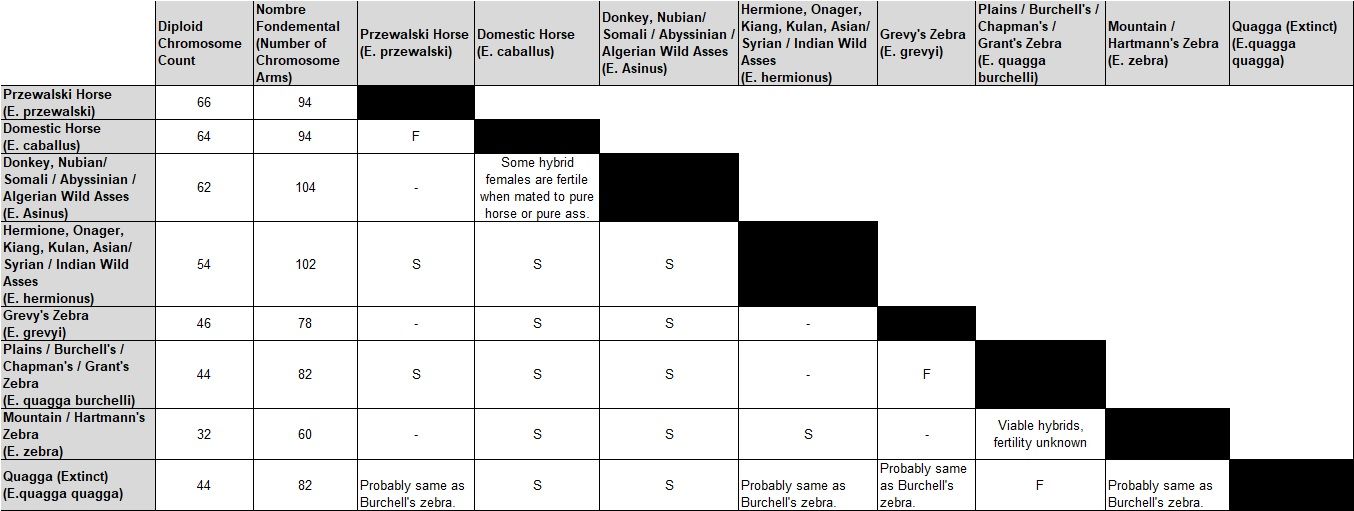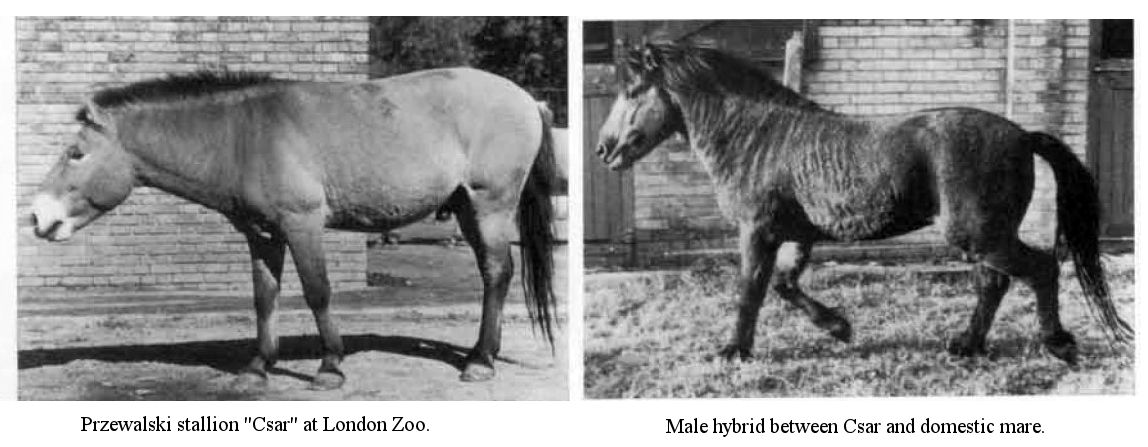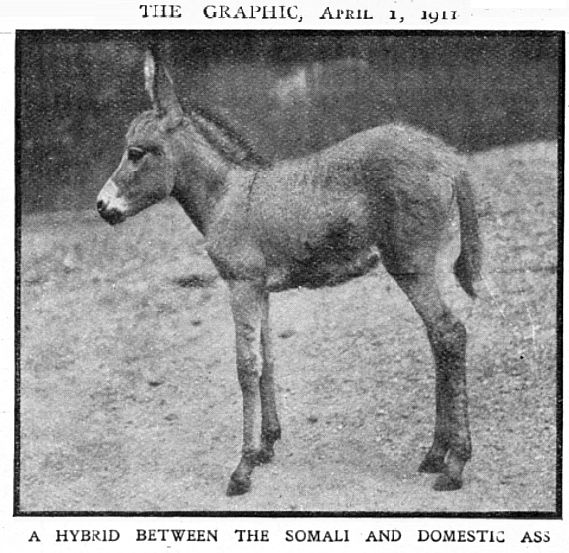
|
OTHER EQUID HYBRIDS, ZEBRA X ZEBRA HYBRIDS |
All equid species will hybridise to produce viable offspring, though the offspring are generally sterile with only a few exceptions. Hybrids between Equus africanus (wild African ass) x Equus asinus (domestic donkey) hybrids are fully fertile. The onager (Equus hermionus) is an Asiatic ass or hermione. Ass/onager and horse/onager hybrids appear to have been bred in the ancient civilisations of western Asia, these having a similar role to modern mules.

PRZEWALSKI HORSE X DOMESTIC HORSE HYBRIDS
Hybrids between the Equus caballus (domestic horse) and Equus przewalskii (Przewalski horse) are fertile despite their differing chromosome numbers (66 for the Przewalski horse, 64 for the domestic horse). Przewalski’s horse was previously considered a primitive wild species, but a 2018 DNA study suggests that it descended from the domesticated horses of the Botai culture (3700–3100 BCE); the Botai horses came from a population distinct from the wild ancestors of modern domestic horses.
Crandall noted that Przewalski's horse interbreeds freely and fertilely with domestic horses and has produced hybrids, probably sterile, with zebras, but did not produce offspring when mated with donkeys (Gray 1954). Although Crandall did not state where these Przewalski hybrids were produced, they may have been at Hagenbeck's Tierpark. As a result, there may be a very low level of domesticated horse blood in some Przewalski's horses today. The herd at the National Zoo's breeding farm at Front Royal, Virginia is known to contain domesticated horse blood.
Male and female Przewalski horse/domestic horse hybrids are fertile, unlike all other known equine hybrids (which cannot produce viable sperm). The Przewalski horse has diploid count of 66 chromosomes, the domestic horse has 64 due to the fusing of 2 chromosomes into 1 (each animal having 2 copies) or splitting of 1 chromosome into 2 (each animal having 2 copies of each). Przewalski/horse F1 hybrids have a diploid count of 65 and are fertile; they are interfertile with both domestic horses and Przewalski horses.
Benirschke and Malouf (1967) suggested that Przewalski’s horse might be the ancestor of domestic horses, its diploid chromosome number having reduced from 66 to 64 during the course of evolution. A recent study of Przewalski horse and both ancient and modern domestic horse genomes indicate that Przewalski horses are the feral descendants of domesticated horses of the Botai culture c. 5700–5100 years ago. (see Kvist, Niskanen, et al. 2021).
Male and female F1 Przewalski/horse hybrids were produced by mating 3 Welsh pony mares to the Przewalski stallion “Csar” at Regent’s Park Zoo (Short, Chandley, et al. 1974). One female and 2 male foals were born after normal domestic mare gestation periods. One of the F1 males died of colic when a yearling. The surviving F1 male was mated to 2 Welsh pony mares when he was 26 months old and these produced an F2 male and F2 female foal after gestation periods which were closer to the Przewalski average. The female F1 hybrid was mated to a Welsh pony stallion when 24 months old, this resulted in an F2 female foal. Two F2 hybrids had a chromosome count of 65 and more closely resembled the Przewalski horse. The other F2 hybrid had a chromosome count of 64 and was indistinguishable from a domestic horse.
The horse family can produce hybrids, even between species with widely differing chromosome counts and configurations. The known hybrids, except the Przewalski/domestic horse hybrid, and occasional mule and hinny mares (when mated to a purebred donkey or purebred horse), are sterile.
- Benirschke, K. and Malouf, N.: Chromosome studies of Equidae. Equus 1: 253-284 (1967).
- Kvist, L., Niskanen, M. Modern Northern Domestic Horses Carry Mitochondrial DNA Similar to Przewalski’s Horse. J Mammal Evol 28, 371–376 (2021).
- Short, R. V., Chandley, A. C., Jones, R. C., and Allen, W. R.
- Meiosis in interspecific equine hybrids. II. The Przewalski horse / domestic horse hybrid (Equus przewalski X E. caballus), Cytogenetics and Cell Genetics. 13, February 1974, 465-478

WILD ASS HYBRIDS
WILD ASS HYBRIDS. (The Field, 27th June 1903) Equus temoinus, Pallas, is usually known as the kiang. Blandford terms it the Asiatic wild ass [. . .] Capt. Sutherland and myself, says that it, breeds freely with the horse, and that the produce is highly valued. There can be, in fact, but little doubt that the mule bred by the kiang would be of the highest value. [. . .] As practical a man as Colonel Kinloch suggested that a cross between the kiang and the horse would prove a most valuable animal, possessing all the good qualities of the ordinary mule, with greater size and strength. [. . .] There were formerly several examples of the Syrian wild ass (Equus hemippus, St Hilaire) in the gardens [London Zoo], and in the catalogue of animals published in 1896 there is a record of a hybrid between this species and the Asiatic ass, which was bred in 1883.

ZEBRA SPECIES HYBRIDS
According to Crandall, some hybrids ("racial intergrades") were foaled by a Hartmann's mare and sired by a Cape stallion between 1924 and 1931; one of these was sent to London Zoological Gardens and figured by Antonius (1951:196). Crandall noted that Gray (1954) listed many crosses between zebras and both horses and asses, wild and domestic. In most cases the male hybrids seemed to be sterile, but there was some evidence indicating that females may sometimes be sterile. Several of these hybrids were figured by Antonius (1954).
According to Dorcas McClintock in "A Natural History Of Zebras," Grevy's zebra has 46 chromosomes; plains zebras have 44 and mountain zebras have 32. The domestic horse has 64 chromosomes. Although all 3 zebra species have been crossed with domestic horses, the 2 dissimilar sets of chromosomes inherited by a zebra hybrid cannot mix because of differences in number, size and shape. As a result, almost all zebra hybrids are sterile. In captivity, plains zebras have been crossed with mountain zebras. The hybrid foals had no dewlap and, except for their larger ears and their hindquarters pattern, they resembled the plains zebra parent. Attempts to breed a Grevy's zebra stallion to mountain zebra mares resulted in a high rate of abortion. In the wild, zebra species don't interbreed even where their ranges overlap or they graze together. This was was also true when the quagga and Burchell's race of plains zebra shared the same area. A hybrid foal from a Somali wild ass bred to a mountain zebra mare had 2 transverse shoulder stripes, leg bands and zebra-like ear stripes.
There are three living species of zebras: the plains zebra Equus quagga, Grevy’s zebra E. grevyi (endangered) and the mountain zebra E. zebra (endangered). The plains zebra has five extant subspecies: Burchell’s zebra E. q. burchelli, Grant’s zebra E. q. boehmi, Selous’ zebra E. q. borensis, Chapman’s zebra E. q. chapmani and Crawshay’s zebra E. q. crawshayi. The mountain zebra has two subspecies: Cape mountain zebra E. z. zebra and Hartmann’s mountain zebra E. z. hartmannae. The plains zebra and the mountain zebra belong to the subgenus Hippotigris, but Grevy’s zebra is the sole species of subgenus Dolichohippus.
Plains and mountain zebras live in stable harems consisting of one stallion, several mares, and their offspring; the harems are expanded by taking mares from the harem they were born into (this prevents inbreeding). Plains zebra groups gather into large herds which may contain sub-groups, but where the structure is more fluid. Grevy's zebra stallions establish large territories and monopolise mares that enter them; mares with young remain in the sire’s territory – if they wander into another territory the stallion will kill the foal in order to mate with its mother. In all species, excess males establish bachelor groups.
Hybridization between Grevy’s zebra and Grant’s zebra, a sub-species of plains zebra has been reported in the wild, resulting in fertile F1 individuals. Hybrids were derived from natural matings between male Grevy’s zebra and female Grant’s zebra in Kenya, and the F1 hybrids remained with the Grant’s zebra group rather than adopting Grevy’s zebra’s social organization, hence gene flow is in one direction: from Grevy’s zebra into the Plains zebra.
Plains x Grevy's zebra hybrids have characteristics intermediate to both parents. Hybrids' stripes are narrower than those of the plains zebra, but wider than those of Grevy's zebra, and their stripes do not meet under the belly. Hybrids have a distinctive ‘waffle-iron’ stripe pattern on top of the rump that is not found in either of the parents. They are also larger than Plains zebra of the same age, but not as large as Grevy's zebra.
Ito et al studied six populations comprised of two pure species (Grevy’s zebra and Grant’s zebra) and four hybridized populations of Grevy’s zebra x Grant’s zebra, including F1 x F1 hybrids (F2 hybrids) and F1 backcrossed to one or other parent species. The backcrossed individuals tended to have ranges overlapping with the backcross parent allowing introgression. The distribution of Grant’s zebra and Chapman’s zebra minimised the opportunities for hybridization in the wild, but they are commonly kept in captivity and are not managed by studbooks, so there is a risk that these sub-species might have hybridized in the past and that some zoo populations are mongrelised.
In the wild, the hybrids were all reared in Plains Zebra herds but displayed significant behavioural differences. They stayed in their birth harems longer than Plains zebra youngsters. In general, hybrid females were more vigilant than Plains females and were as vigilant as Grevy's females. In general, male hybrids were solitary more often and changed status more often (bachelor, satellite, challenger, harem stallion, solitary). Some hybrid males behaved like plains zebra males i.e. challenging for harems while others set up territories in the same way as Grevy's males. Although hybrid males succeeded in taking over harems of Plains zebra females, they did not keep them for more than a few days, behaviourally more like Grevy’s zebra males which mate with visiting females rather than forming long-term bonds with females (meet, mate, move on).

Hybridisation has been recorded between the Plains and Mountain zebra, though it is possible that these are poorly fertile due to the difference in chromosome numbers between the two species. Historically, Cape Mountain zebras were widespread along mountain ranges in the Eastern and Western Cape provinces of South Africa, but by the 1930s, hunting and habitat loss drastically reduced their numbers and resulted in isolated populations. Today, only three relic populations remain and are now protected. Cape mountain zebra began to recover Plains zebra were introduced into the same areas because the two species had previously cohabited and were not known to interbreed. Conservationists were not concerned about hybridization because fertile hybrids seemed be unlikely because Plains zebra have 44 chromosomes and Cape Moutain zebra have 32 chromosomes. Such a difference should mean that offspring either don’t occur (aborted, stillborn) or aren’t fertile. By 2013, the plains zebra needed to be removed because of competition for resources with the endangered Cape Mountain zebra. This resulted in small, fragmented groups of Plains zebra, some of which joined Cape Mountain zebra herds. Conservation officials also observed Cape mountain zebras that had plains zebra characteristics: slight shadow striping, stripes extending all the way down to the middle of the belly and chest, and, although they had the Cape Mountain zebra’s reddish muzzle they lacked its characteristic “waffle-iron” pattern on the rump and either had no pattern or a distorted pattern instead. They had the Cape Mountain zebra’s distinct dewlap, but the ears were more similar to the Plains zebra. It seemed that viable hybrids were possible after all.
Textual content is licensed under the GFDL.
|
BACK TO HYBRIDS & MUTANTS INDEX INDEX |